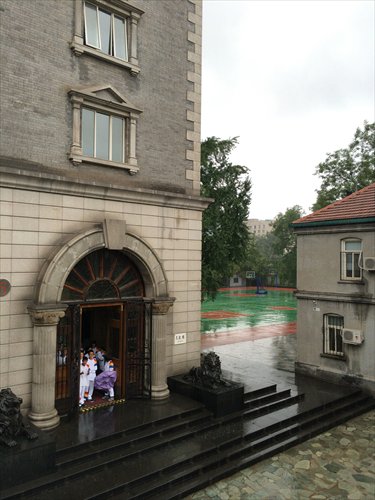

One of the buildings on the campus of Beijing No.25 Middle School, which was formerly a missionary school known as Yu Ying. Photo: Li Ying/GT
Many years later, as he compiled the official documents, personal memoirs, and faded photographs that would be displayed to commemorate the 150th anniversary of the school once run by Christian missionaries, Qi Bing remembered the magnificent Dengshikou Congregational Church that for many years kept vigil over its grounds.
"As a child, I was able to go inside, because my mother worked at the school. The architecture was so intricate, so exquisite," Qi recalled. "The floor was made of wood that had been imported from America, and inside, there was the most majestic organ."
Qi stares out the window, lost in his own memories. The head of the worker's union at the school, Qi is sitting in a small room in one of only three buildings which were built about a century ago. The room overlooks the empty playgrounds of what today is known as Beijing No.25 Middle School.
It is a school that now looks much like any other in Beijing. Where the church once stood, with its looming gothic spire and intricate stained glass windows, is now a four-story classroom building that also more or less resembles any other.
But back then, at the calamitous end of the 19th century, it was one of Beijing's first Protestant-run schools. Founded by Christian missionaries after China's defeat in the Second Opium War, it served both as a place for learning, and a tabernacle to spread the word of God.
"At the time, there were only privately-run home schools in China, said Qi. "The missionary schools represented an alternative to the Chinese system of education."
There would be classes in the natural and social sciences, but above all, it was a place where Christian values could be nurtured and flourish. Back then, it was known as Yu Ying School.
A tabernacle for Beijing's social elite
Yu Ying was one of two missionary schools set up by the American Board of Commissioners for Foreign Missions in 1864, four years after China's defeat in the Second Opium War.
Yu Ying was set up for the education of boys, and a neighboring school, Bridgeman, was set up for the education of girls.
"At the beginning, Yu Ying mainly provided religious instruction and studies in the Bible," said Qi. But it was the school's instruction in subjects considered by its missionary founders to be secondary that saw its appeal broaden beyond those families who were already inclined toward Christianity. Coupled with the school's penchant for encouraging its students to explore, with a spirit of inquisitive curiosity, whatever hobbies or interests might tickle their fancy, it gained a reputation for providing the kind of education that student needed to navigate the tumultuous, rapidly transforming society of China before the turn of the 19th century.
"The school started attracting children from middle and upper-class families in Beijing, who were not necessarily interested in converting to Christianity," said Qi.
The status the two schools enjoyed as the breeding ground of Beijing's social elite was however, short-lived. By the beginning of 1900, the Boxer Rebellion, a populist revolt against what its instigators saw as the corruptive influence of foreign powers in China, had reached the zenith of its violent outrage. Targeting sites of Christian fellowship as symbolic of foreign imperialism, both the Yu Ying and Bridgeman schools suffered heavy damage. Among the casualties was the church which Qi today recalls with such fondness.
The church and the school were rebuilt in 1904 with the support of the Qing government, but after 1911, with the founding of the Republic of China, the schools were forced to make concessions.
Rather than operating outside of the jurisdiction of Chinese authority, they were obligated to conduct its affairs under local administration. Along with its foreign headmasters, a Chinese headmaster would be appointed to each of the missionary schools. Furthermore, the schools' curriculums would be overseen by the Chinese bureaucracy, meaning that more and more classes would be taught in Chinese, responding to the cultural and vocational needs of the emerging state.
Chronicles of a schoolgirl
Under the new arrangement, missionary schools in China began to flourish again. By 1916, there were 291 missionary schools in China registered with the authorities, making up about 40 percent of all schools registered in China at the time.
During this period, the missionary schools produced a number of outstanding alumni. Among them was Xie Wanying (1900-1999), a renowned essayist, translator, and author of children's books whose works in her latter period are considered among the most important contributions to modern Chinese literature.
Copyright ©1999-2018
Chinanews.com. All rights reserved.
Reproduction in whole or in part without permission is prohibited.